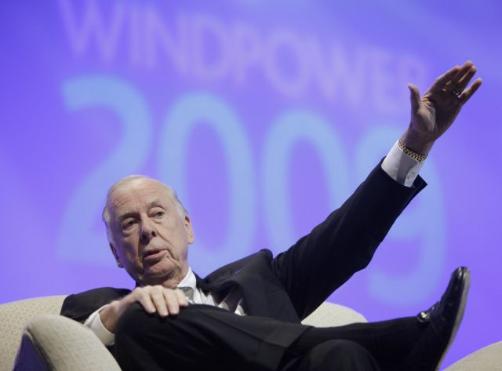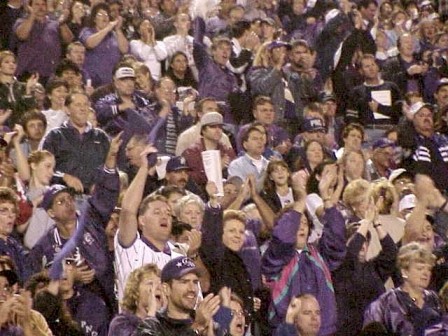Camp Wolfgang’s founder Wally Swanson has died
June 30th, 2011
(photo fair use from examiner.com)
8 German Shepherds need homes…
Wally Swanson, the founder of Camp Wolfgang, a German Shepherd rescue, died last week. Services were held today, in Minnesota! He closed down Camp Wolfgang in October of 2009, and after that, keeping only a few dogs as health issues made it difficult for him to keep up. When I first learned of Camp Wolfgang, there were over 300 dogs he was caring for, and I’d thought that when Ken and Krie died, I’d get a dog from Camp Wolfgang, but he closed it before then. The GSD rescue world was scrambling when he shut down working to accommodate over 120 GSDs and other dogs, but they did it, all the dogs who needed homes were adopted out or sent to rescues across the country.
He also founded a program called “Paws in Prison” where local prisoners worked with dogs, training the dogs for future adopters (and training themselves in the process). Here’s a blog post about a 2007 Paws in Prison graduation:
In the STrib:
Wallace Martin Swanson
Xcel had 9,083 peak in June?
June 29th, 2011

(Yes, that’s Summer grrrrrrrrrrl.)
Remember how hot it was back a couple of weeks ago? Xcel’s Tim Carlsgaard was again bragging about Xcel’s peak:
9,083 MW
There’s plenty of time this summer to ramp it up higher, but so far, 9,083.
Here’s Xcel’s peak demand for the last decade, taken from their 10-Ks filed with the SEC:
 Carlsgaard’s number came from an informal calculation or two, interruptible service was part of it, and I think it was deducted, but you never can be sure with a PR shill!!! Anyway, 9,083MW is nothing to write home about. If you remember, Capx 2020 was based on a 2.4% increase ANNUALLY. If we’d done that, starting from 2005, we’d be at:
Carlsgaard’s number came from an informal calculation or two, interruptible service was part of it, and I think it was deducted, but you never can be sure with a PR shill!!! Anyway, 9,083MW is nothing to write home about. If you remember, Capx 2020 was based on a 2.4% increase ANNUALLY. If we’d done that, starting from 2005, we’d be at:
10,620 MW
So we’re down about 1,600MW from their projections, and from what CapX was based on…
Their projections of a 2.4% increase annually add up quickly:
2005 – 9,212
2006 – 9,433
2007 – 9,659
2008 – 9,891
2009 – 10,128
2010 – 10,371
2011 – 10,620
In 2006 they jumped ahead of projections by a couple of years, but since then have dropped further and further behind, now with a peak trailing behind the peak of 2005…
So one way of looking at it is that they’ve pushed the “need” for additional power out for years.
Another way of looking at it is that they’re about three 500MW coal plants shy of what they projected.
Another way of looking at it is that they 1,600MW short is about Prairie Island’s and Monticello’s three nuclear reactors short.
Another way if looking at it is that it’s 1,00MW of cheap generation for wholesale and there’s plenty of room on 2,050-2,211 MVA (4,100-4,422 MVA double circuited) CapX 2020 transmission to ship that over to points east… (see MCEA, ME3, Waltons Schedin IR3)
So Tim, do tell, where am I off here??? p.s. Always check my math, I’m an attorney, not a vet, because my brain has grey sponge in the math department.
ILSR’s Farrell on Fed Transmission Scam
June 29th, 2011
ILSR’s John Farrell is halfway there – he recognizes the federal part of the transmission equation, but the state part is missing, for example, Minnesota’s special eminent domain exemptions for “Public Service Corporations” (particularly where the transmission is for private profit, NOT public service), rate recovery for “Construction Work in Progress” and state regulators refusal to examine the interstate nature of transmission proposals. And the third part of that unholy trinity — in the Midwest, bulk power transmission would not be being built but for the Settlement Agreement – ME3(Fresh Energy), Izaak Walton League (and Walton’s program Wind on the Wires), Minnesota Center for Environmental Advocacy, and North American Water Office. This glut of transmission is their legacy. It takes all three to build transmission.
From Grist, today:
Feds running a high-voltage gravy train for power transmission
by John Farrell
28 Jun 2011 6:00 AM
Even as distributed generation shows economical and political advantages over centralized renewable energy, the Federal Energy Regulatory Commission (FERC) is running a high voltage gravy train in support of expanded transmission. FERC’s lavish program is expanding large transmission infrastructure at the expense of ratepayers instead of looking at more economical alternatives.Since 2007, FERC has had 45 requests for bonus incentives for transmission development — authorized under the 2005 Energy Policy Act — and has provided all or most of the requested incentives in more than 80 percent of the cases. With the bonuses, the average return on equity for utilities for their new transmission investments is nearly 13 percent. This high rate of return is a full 2.5 percentage points higher than the median utility return on equity [PDF], a value considered just and reasonable by state public service commissions in ordinary times. However, these rewards came during a time when unemployment doubled, the stock market tumbled, and most corporations were lucky to have any profit.The ratepayer impact of these bonuses is significant. In a November 2010 criticism of FERC transmission awards, Commissioner John Norris noted that the 2 percent bonus FERC provided to the PATH high-voltage project on the Eastern seaboard would “cost [Maryland] ratepayers in PJM at least $18 million per year.” The bonus payments were also given in concert with other incentives that reduced risk, including rate recovery during construction and guarantee of payment if the facilities were abandoned for reasons outside utility control.
OAH’s continuing efforts to chill participation
June 28th, 2011
You may remember prior posts about that but I’ll start from the beginning and try to make it quick. There’s a pattern at the Office of Administrative Hearings that is disturbing…
Way back on the MinnCan pipeline, members of U-CAN had tried to intervene and were refused. They got late notice and were not represented, stumbling through the administrative process pro se. MPIRG showed an interest and started working on it, among other things, submitting a Petition for Intervention:
Despite the late notice and their attempts to “work within the system,” the Petition of MPRIG individual U-CAN members was denied:
And when they appealed, they were tossed out, as if they had not even tried to intervene:
So when CapX 2020 hit, and they filed a Certificate of Need and landowners learned it wasn’t just the pipeline, but now transmission TOO (how much can a landowner stand?) they got right to it, and intervened as United Citizens Action Network (U-CAN), participating pro se as they had no resources to hire an attorney and were in condemnation and appellate court at the time. They Petition, and were admitted as full parties. So what happens?
Judge Heydinger, the same ALJ in the CapX Certificate of Need case as in the MinnCan pipeline case, files sua sponte (on her own initiative, not a Motion brought by parties) a demand that they explain why they, and the Prairie Island Indian Community, should remain intervenors:
This had been done before in the Excelsior Energy Mesaba Project siting docket, where ALJ Steve Mihalchick booted out Xcel Energy, Minnesota Power, and my client, Public Energy – Mesaba, because no testimony had been provided:
This docket went forward, there were two days of hearings, first in Taconite, where ALJ Mihalchick rammed through 4 witnesses and where we weren’t provided adequate opportunity for questioning, and, I swear, when I tried to get a table, he said, “Whatever would you need a table for?” Really… after much hassle, Bill Storm of Commerce found one (thank you!!). Since that day, I bring my own. Anyway, the second day, it was -30 in Hoyt Lakes and the hearing was in the unheated gym next to the hockey rink.
That day, Judge Mihalchick rammed through … what… 16 witnesses?… in one day, and left saying, “I’m not coming back here.”
Travesty doesn’t begin to characterize that hearing. And worse, Excelsior Energy got a permit for a vaporware project:
Fast forward to 2011, where ALJ Heydinger has now again issued a similar Order to Show Cause regarding two intervenors, Energy Cents and Verso Paper:
Here’s Verso Paper’s response:
Just filed: Order Confirming Party Status – Verso Paper
Where’s the Energy Cents Coalition?
Anyway, I’ve submitted a Rulemaking Petition to OAH about Minn. R. Ch. 1400 & 1405 to try to address some of this. We shall see…
PUC Briefing Papers for Goodhue Wind
June 23rd, 2011
Thursday, June 30, the last day before the state government shuts down, the Public Utilities Commission will hear oral arguments and deliberate and likely decide fate of the AWA/Goodhue Wind Project.
The Staff Briefing Papers matter-of-factly point out a couple of things that make a huge difference in this case:
In the ALJ’s December 8, 2010 First Prehearing Order, Order point #13 noted:
13. As noted above, the parties may submit legal argument on how the good cause standard should be applied, if at all, in their closing memoranda. In particular, the Administrative Law Judge would like the parties to brief the issue whether Minn. Stat. 216F.081 (2008) is intended to apply only to counties that have assumed the responsibility to process applications and issue permits for LWECS with a combined nameplate capacity of less than 25 MW pursuant to Minn. Stat. 216F.081. …
This is not an issue that the Commission referred to the ALJ. The ALJ’s findings on this issue are included in her report as findings #39 – 47.
And shortly after that:
Staff recommends that the Commission consider all parties‟ positions on this matter and their previous November 2, 2010 Order for Hearing (cited above).
Staff believes that if the Commission comes to the same conclusion as the November 2, 2010 Order, it should strike ALJ findings #40-46 on the basis that the Commission has already considered this matter and the matter was not referred to the ALJ. Findings #39 and 47 are general in nature and staff doesn’t believe the findings would need to be omitted.
The recommendation of staff to the Commissioners? Hold on to your seats:
Staff recommends adopting the ALJ’s Report with the following changes:
1) modifications to findings #10, 60 and 71 as outlined in Attachment B under “Staff”;
2) striking findings #40-46, as discussed above; and
3) providing for other modifications the Commission deems necessary.
YEAAAAAAA! From there to where this should be isn’t all that far…
To watch the oral arguments and PUC’s deliberation, CLICK HERE and then click the blue button to “Watch Webcast!” Or come on down, Thursday, 9:30 a.m. ( a little after, we’re 2 and 3 on the agenda), at 121 – 7th Place East, 3rd Floor, Large Hearing Room, St. Paul, MN, 55101.









